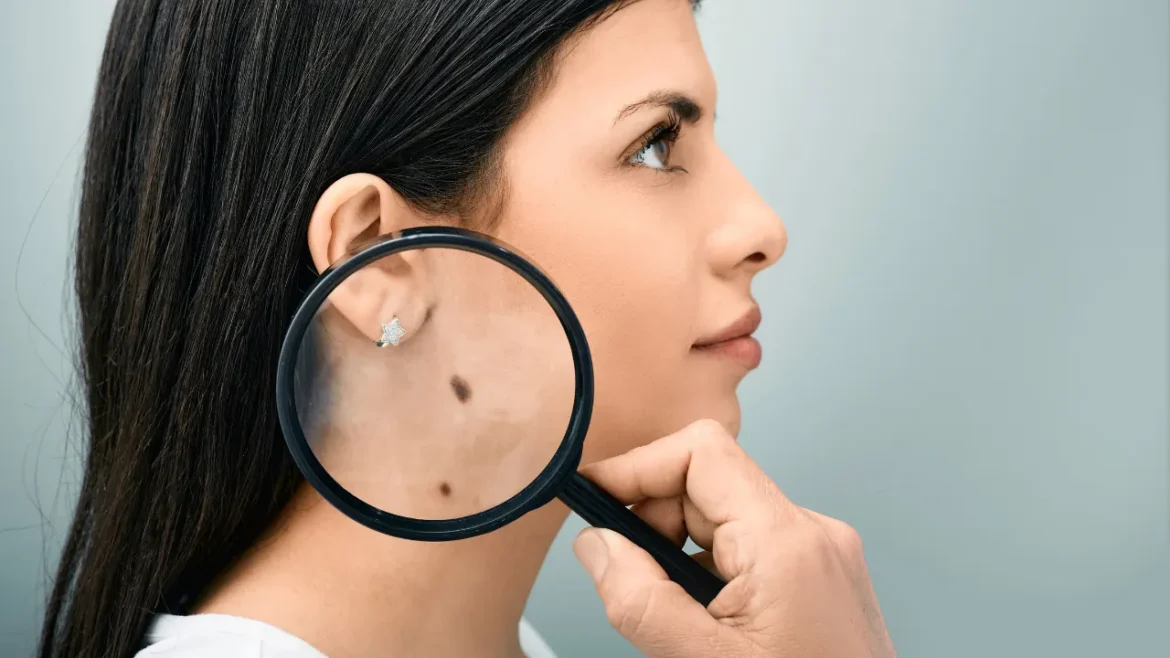The Nature of Moles
Description
The term, mole, refers to a group of benign skin growths, commonly referred to as nevi, that are typically small, black spots to dark brown or patches on one’s skin. The dimension, shape, and color may all vary, and hormone changes, UV exposure, and heredity can all affect how they seem. Moles often have well-defined borders, are oval or round in shape, and are one color throughout. Some moles can grow to be a few centimeters in diameter, but others can be as little as tiny spots or larger regions.
Moles can develop on any part of a person’s body, including the head, neck, face, chest, arms, back, arms, and legs. They can appear later in life, i.e., acquired moles or develop at birth, i.e., congenital moles. A person could have a single mole or several. Certain people may only have a few moles, whilst others may have several moles scattered across their skin. The color of moles is generally constant and typically fluctuates between dark brown and light brown or black.
You May Also Like:
THE CBD BUSINESS IS BOOMING. HERE’S WHY.
SEBORRHEIC KERATOSES: DESCRIPTION, CAUSES, AND TREATMENT PROTOCOL
Moles: Description, Causes, And Treatment Protocol is an original (HealthXWire) article.
Possible Causes
It is unclear what exactly causes moles. Nevertheless, several kinds of factors influence their existence and growth. Some of the main factors that generate moles include:
Sun Exposure: Numerous environmental factors, like sunlight exposure, have an impact on moles. Sunlight’s ultraviolet (UV) radiation may trigger melanocyte development and accumulation, which can lead to moles. Since fair-skinned people are more susceptible to UV damage, this is especially true for them.
Genetic Predisposition: Mole growth is significantly influenced by genetic factors. The likelihood of developing moles increases for people who have people in their families with them.
Age: Youth and adolescence are the best times to check for moles. Even till 30 years of age, they can still develop. Existing moles, nevertheless, can alter in size, form, or color gradually as a result of numerous events.
Hormonal Changes: Moles can arise as a result of hormonal changes. For instance, moles may develop or change color during pregnancy, puberty, or hormone treatments. Moles can arise as a result of hormonal fluctuations that occur during these times by stimulating the activity and multiplication of melanocytes.
Hormone-Related Conditions: The possibility of acquiring moles may be increased by a few hormonally related illnesses, like PCOS or abnormalities involving the adrenal gland.
Congenital Factors: Congenital moles, also called birthmarks, include certain moles that develop before or shortly following birth. Scientists hypothesize that such moles, which can be bigger or more pigmented compared with acquired moles, result from irregularities in skin formation.
Immune System Factors: According to several research, immune system-related variables might be involved in the formation of moles. Atypical or many moles can be more likely to appear in immunocompromised people or people with specific immunological diseases.

Exacerbating & Mitigating Factors of Moles
The aggravating factors for moles:
Hormonal Changes: Moles may be increased in growth by certain hormonal changes. Moles can develop and appear differently at various times due to hormonal swings and elevated levels of some hormones.
Sunlight Exposure: The growth of moles is significantly exacerbated by prolonged and strong sunlight that emits ultraviolet (UV) light. Moles may appear more frequently and may have a higher chance of developing into cancer due to genetic changes brought on by UV radiation within the skin cells.
Tanning Beds: Moles may additionally develop and spread as a result of using sunlamps and tanning beds, which produce artificial UV radiation. Artificial UV radiation exposure raises the chance of mole development on your body, similarly to the effects of being exposed to natural sunshine.
The alleviating factors for moles are:
Hormonal Balance: Hormonal implications on mole growth can be managed by maintaining hormonal balance with appropriate medical measures, including hormone replacement therapy or contraceptive techniques.
Early Diagnosis and Treatment: The risk of problems can be decreased by swiftly identifying abnormal moles and beginning early therapy. If a mole develops major changes or displays questionable characteristics, it is imperative that you visit a dermatologist.
Sun Protection: Moles can be lessened in severity by using sensible sun protection techniques. These actions are comprised of:
- Sunscreen
Apply any broad-spectrum sunscreen containing an SPF of a minimum of 30 or more to all the exposed skin, including the area where moles are present. Sunscreen users ought to reapply more frequently every two hours, whether someone is swimming or sweating.
- Protective Clothing
To protect one’s skin from intense sunlight, dress in protective gear like long sleeves, wide-brimmed hats, and slacks made of light and breathable materials, so as to not overheat.
- Seek Shade
Limiting time spent in direct sunlight is important, particularly from 10 am to 4 pm when the rays of the sun become the most intense.


Standard Treatment Protocol for Moles
The kind of mole, its features, and its likelihood of becoming cancer all affect the typical treatment strategy for moles. The following are typical types of treatment:
Surgical Excision: This is the most typical technique for eliminating moles. The mole, along with a tiny portion of the adjacent healthy skin, must be removed. Typically, local anesthetic is used during the surgery, and the removed tissue is then sent for histological analysis to check for the presence of any abnormal or malignant cells.
Shave Excision: Raised moles without cancerous symptoms can be treated with this technique. Employing a scalpel, the mole is removed from the surface of the skin. The scarring from shaving excision is often not severe and rarely calls for stitches. There exists a tiny chance of recurrence, as it might not completely eliminate the mole.
Laser Removal: Focused laser beams are utilized during laser therapy to destroy the mole’s pigment-producing cells. This approach is appropriate for smaller, less darkly pigmented, non-cancerous moles. For best results, laser removal might require numerous sessions, and it might result in transient swelling and redness on a person’s body. For moles on the face or other regions where appearance is important, this treatment is frequently preferred.
Cryotherapy: The mole is frozen with liquid nitrogen during cryotherapy, which kills the mole cells. Over time, the frozen tissue peels off or is removed, and fresh skin grows in its place. Smaller and non-cancerous moles are frequently treated using cryotherapy, which may require numerous sessions.
Electrocautery: Utilizing an electrical current, electrocautery entails burning the mole off. This kind of therapy may leave a minor scar and is appropriate for small and non-cancerous moles. For worrisome or malignant moles, this treatment type is typically not advised.


Treatment Options for Moles
To boost the efficiency of conventional therapies and enhance skin health, a variety of alternative treatments and herbal medicines may be utilized in addition to the standard course of treatment. The following includes a few potential additional therapies for moles:
Nutritional Supplements: The skin’s health and healing procedure may be supported by specific dietary supplements. Supplements high in antioxidants, including vitamins A, E, and C, zinc, and selenium, could improve your body’s defense mechanisms against oxidative stress while encouraging the maintenance of healthy skin.
Herbal Remedies: Traditional uses of some herbal treatments for skin health exist. Tea tree oil, aloe vera, apple cider vinegar, and garlic are some examples of ingredients that may be anti-inflammatory, antibacterial, and antioxidant. Such medications can be used topically when instructed how to do so by a medical expert.
Routine Skin Examinations: Monitoring moles and detecting any changes that could suggest cancer requires both routine self-checkups and expert skin inspections. Asymmetry, uneven boundaries, changes in color, and diameter, along with evolution are called the ABCDE guideline over others, and people should be conscious of these and communicate any suspicious modifications to a medical professional immediately.
The selection of a course of therapy is influenced by a variety of elements, including the mole’s dimensions, position, and features, the patient’s choices, and the dermatologist’s experience. In order to safely rule out the risk of skin cancer, a dermatologist ought to examine any worrisome or changing moles you have. It is best to get professional medical guidance because the right course of therapy will vary depending on the mole’s features and the patient’s unique situation.


Moles:
Conclusion
Moles have a lot of variation. Some of the variation is benign and nothing to worry about. Other variations in the presentation of moles are indeed worrisome. It’s up to you to take action, including reading this article, in order to learn more about how to tell the difference between when a mole is a unique characteristic, and when it is more of a medical emergency.
- “Common Moles, Dysplastic Nevi, and Risk of Melanoma.” Retrieved from: https://www.cancer.gov/types/skin/moles-fact-sheet
- “How do dermatologists tell whether a spot is a mole?” Retrieved from: https://www.aad.org/public/diseases/a-z/moles-treatment
- “Should I worry about a mole?” Retrieved from: https://www.medicalnewstoday.com/articles/233838
- “What Are Skin Moles?” Retrieved from: https://www.healthline.com/health/skin-moles
Important Note: The information contained in this article is for general informational purposes only, and should not be construed as health or medical advice, nor is it intended to diagnose, prevent, treat, or cure any disease or health condition. Before embarking on any diet, fitness regimen, or program of nutritional supplementation, it is advisable to consult your healthcare professional in order to determine its safety and probable efficacy in terms of your individual state of health.
Regarding Nutritional Supplements Or Other Non-Prescription Health Products: If any nutritional supplements or other non-prescription health products are mentioned in the foregoing article, any claims or statements made about them have not been evaluated by the U.S. Food and Drug Administration, and such nutritional supplements or other health products are not intended to diagnose, treat, cure, or prevent any disease.
Table of Contents


